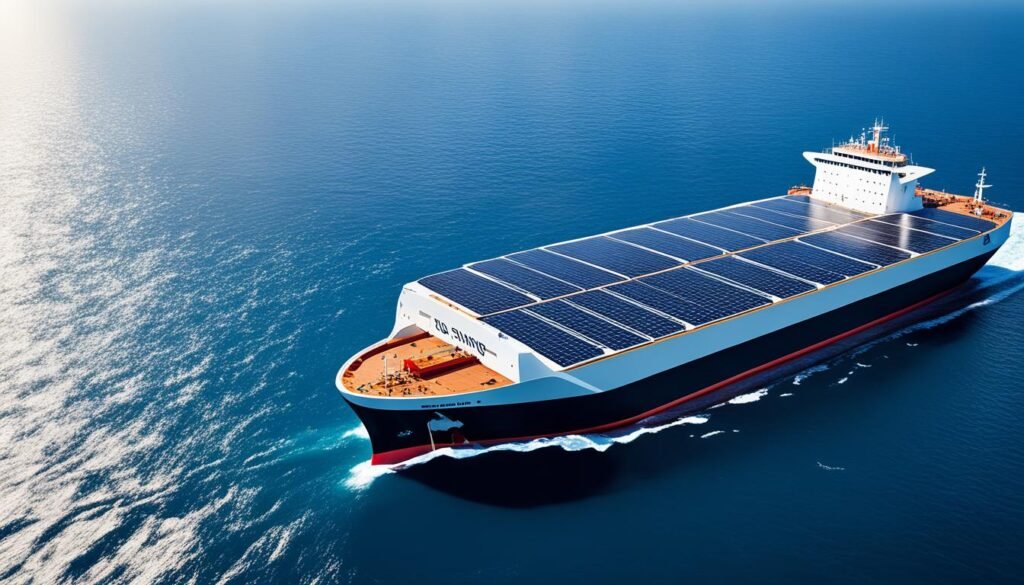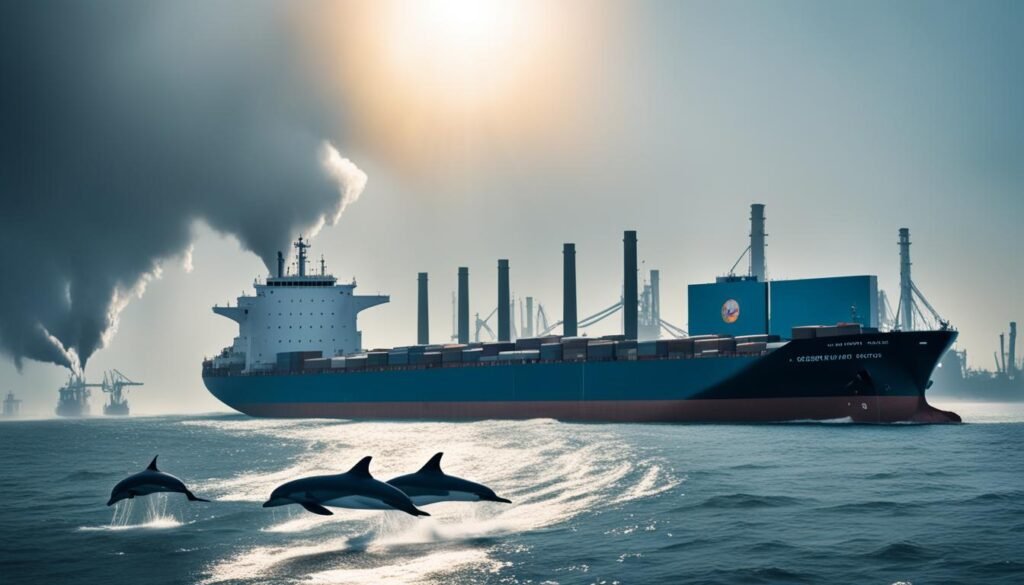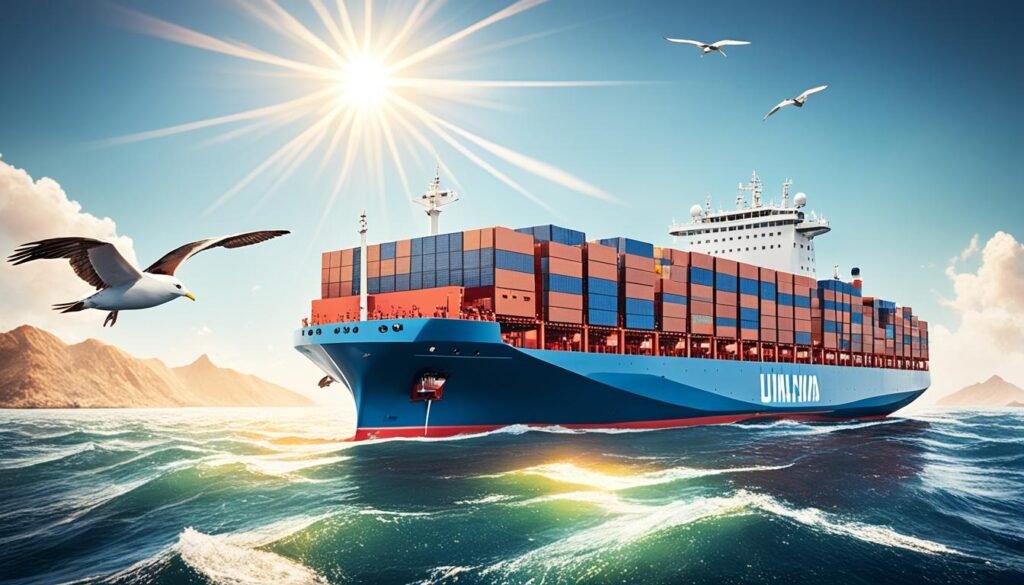Looking out at the ocean, I saw cargo ships moving through the waves. These ships carry most of the world’s goods but harm the environment by emitting a lot of carbon dioxide. What if we could use the sun’s power to make them cleaner?
Finding a way to make shipping sustainable is hard, but some people are trying. Gunter Pauli, a Belgian entrepreneur, wants to change the industry with renewable energy. His ship, the MS Porrima, is a solar-powered vessel starting a three-year journey from Osaka, Japan. It shows us what the future of green shipping could be.

Thinking about solar power for cargo ships makes me curious. Is it possible, or just a dream? Let’s look into the challenges and new ideas. We’ll see if using the sun’s energy can change how cargo ships work.
The Need for Sustainable Shipping Solutions
The shipping industry is key to global trade but has a big environmental impact. It produces 3.1% of the world’s carbon dioxide emissions and 13% of sulfur oxide emissions. This shows the need for sustainable shipping solutions.
Environmental Impact of Maritime Transportation
Shipping affects the environment in many ways. Ships use fossil fuels, which release harmful gases and pollutants. This harms air quality, marine life, and the climate.
Challenges in Reducing Emissions from Cargo Vessels
Lowering emissions from cargo ships is hard. Ships face changing conditions like weather and motion. Companies are looking at solar energy, but it’s tough due to these challenges.
| Emission Type | Percentage Contribution by Shipping Industry |
|---|---|
| Carbon Dioxide (CO2) | 3.1% |
| Sulfur Oxide (SOx) | 13% |
| Nitrous Oxide (NOx) | 15% |
The table shows the big environmental impact of shipping. It’s clear we need sustainable solutions to tackle these issues. The industry must work to reduce its environmental footprint.

Exploring Solar Power as a Renewable Energy Source
Advantages of Solar Energy for Maritime Applications
The maritime industry is looking to cut down on its environmental impact and move towards sustainability. Solar power is becoming a key focus. Even though solar energy isn’t as common at sea as it is on land, researchers see its potential for solar-powered vessels, green vessel power, and eco-friendly maritime logistics.
Using solar energy maritime tech could lead to zero-emission shipping and clean cargo transport. Solar-powered electric boats could cut down on fossil fuel use, reducing carbon emissions and making the environment cleaner. Better solar panel technology and energy storage have made photovoltaic cargo ships and renewable shipping more practical.
Studies show that combining solar power with other renewables like wind power can save up to 30% on fuel for large ships. These photovoltaic ship systems and alternative fuel for vessels could change the future of sustainable maritime transport.
| Fuel Savings | CO2 Emissions Reduction | Solar-Powered Electric Boats |
|---|---|---|
| 10-30% on large ships with rigid sails | Approximately 3,000 tonnes annually on large ships with integrated solar and sail power | Significantly lower carbon footprint compared to traditional boats |
The upfront cost for solar-powered vessels is high, but the long-term savings on fuel and environmental impact make it more appealing. As technology gets better and costs go down, photovoltaic cargo ships and clean energy for cargo fleets could be key to sustainable maritime logistics.

Pioneering Solar-Powered Cargo Ships
The Porrima: A Revolutionary Solar Vessel
The maritime industry is looking into new tech to cut down on emissions and harm to the environment. The Porrima, a 100-metric-ton catamaran, is leading the way. It’s the biggest solar-powered ship in the world.
This ship has 29,124 top-notch silicon solar panels. It’s made of lightweight, strong materials. The Porrima has traveled around the globe without using any fuel. This shows how solar-powered cargo vessels and renewable energy in the shipping industry can work.
Captain Gerard D’Aboville says solar power isn’t yet right for big ships. But the Porrima shows what’s possible with green shipping solutions and emission-free cargo transport. Now, it’s on a scientific trip. Its clean exhaust makes it perfect for studying the ocean and air, proving its eco-friendly shipping practices and clean energy for maritime fleets.
The Porrima is a symbol of the industry’s push to be greener and decarbonize. It shows the power of green maritime technology and solar-assisted propulsion. This ship is a beacon for the future of sustainable shipping.

Solar Power on Cargo Ships
Solar power is becoming a key part of making cargo ships greener. It helps cut down on emissions and fuel use. Projects show how solar panels on ships can give a lot of electricity, reducing the need for dirty fuels.
Adding solar power helps make sustainable maritime practices better. It also lowers shipping costs by reducing fuel bills. Using solar power with wind power is a good way to make cargo ships cleaner and cut emissions.
The shipping industry is looking into many clean energy initiatives to meet the Paris Agreement goals. This agreement wants to keep global warming under 2°C. As more companies want renewable energy solutions for shipping, solar power is key to a greener future for ships.
Getting to fully solar-powered cargo ships is still a long way off. However, using photovoltaic systems on vessels and exploring hybrid energy sources is a good start. As the industry keeps innovating, a greener future for sustainable maritime transportation is getting closer.
You can check out this article on Eco Marine Power’s wind and solar-powered ship unveiled in Japan
Overcoming Obstacles in Marine Solar Power Integration
The use of solar power in the shipping industry is promising. However, it comes with challenges. Cargo vessels face changing locations, weather, and constant motion. These make it hard to capture solar energy well.
The sea’s unpredictability, like pitching and rolling, affects solar panel efficiency. Ships can turn, which also impacts solar panel performance.
Technical Challenges of Solar Panel Installation on Ships
Installing solar panels on ships is tough. There’s limited deck space and the vessel’s structure must stay strong. Designing solar panels that can handle saltwater and high winds is a big task.
It requires special skills and materials to make them last.
Optimizing Solar Energy Capture on Moving Vessels
Getting the most out of solar panels on ships is hard. Traditional systems don’t work well with a ship’s changing position. New solar tracking systems and flexible panels are being tested to boost ship photovoltaics efficiency.
Overcoming these challenges is key to solar power on cargo ships and decarbonizing the shipping industry. Working together is vital. Shipbuilders, shipping companies, tech providers, and policymakers must collaborate. This will help develop clean shipping innovations and alternative ship propulsion solutions.
Hybrid and Complementary Solutions for Greener Shipping
Solar power alone might not fully replace fossil fuels in shipping. But, mixing it with wind power and battery storage could cut emissions. A project showed a hybrid system with solar, batteries, and engines. It provided 10 percent of the electricity needed, cutting fuel use and emissions. This mix could be a smart, cost-effective way to bring renewable energy to the seas.
Combining Solar with Wind and Battery Power
By 2024, over 50 ships will use solar sails for power. Adding solar panels to a medium-sized cargo ship costs $2 to $5 million. Some ships using solar and traditional engines have seen a 20% decrease in fuel consumption.
| Renewable Energy Adoption | Fuel Savings | Emissions Reduction |
|---|---|---|
| 30% increase in the adoption of renewable energy sources among fleets of member states has been noted by the International Maritime Organization (IMO). | Hybrid cargo ships and ferries utilizing both solar power and conventional engines have reported up to a 20% decrease in fuel consumption. | The Aquarius MRE system, a wind and solar-powered solution, aims to save approximately 1000 tonnes of bunker fuel annually and reduce approximately 3000 tonnes of CO2 emissions on large ships. |
Advances in materials science have made solar tech for the sea better and cheaper. New solar panels for ships are 20% more durable and efficient than old ones. This mix of renewable marine fuel, vessel emissions reduction, and green logistics is a big step towards eco-friendly transportation and decarbonizing global supply chains.
Conclusion
The shipping industry uses a lot of fossil fuels, which harms the environment. It leads to more carbon emissions, air pollution, and damage to marine life. Yet, projects like the Porrima show how marine solar energy could change clean cargo shipping for the better.
These projects aim to solve the challenges of putting solar panels on ships. By mixing solar with other green shipping technologies, the industry can become more sustainable. This could lead to a greener future for shipping.
Using solar power and other clean energy for freight shipping can lessen the industry’s harm to the environment. Emission reduction strategies for vessels and green maritime initiatives are key to an eco-friendly ship propulsion future.
The need for sustainable shipping is growing. The industry must adopt new technologies and renewable energy to become greener. By leading in clean cargo shipping, the maritime sector can help fight climate change and protect the environment.
FAQ
What is the environmental impact of the shipping industry?
Ships for trade release more carbon dioxide than planes do every year. They harm marine ecosystems. The shipping industry is responsible for 3.1% of the world’s carbon dioxide emissions. It also accounts for 13% of sulfur oxide and 15% of nitrous oxide emissions. This has a big impact on the planet’s health.
What is the Porrima and how is it revolutionizing the shipping industry?
The Porrima is a solar-powered ship made by Gunter Pauli, a Belgian entrepreneur and economist. It’s changing the shipping world by using renewable energy like hydrogen from seawater and solar power. The ship is traveling around the globe, starting in Osaka, Japan, and will reach the US west coast by 2024.
Why is the use of solar power in the maritime industry limited?
Solar power in the marine industry is hard to use because of the challenges ships face. These include changing locations, weather, and motion. These make it tough to keep solar panels facing the sun for the best energy capture. Weather, ship movements, and turning also affect solar panel efficiency.
How can solar power be integrated into the shipping industry?
Solar power might not fully power ships alone, but it can help cut down on emissions. A project showed solar panels could give a cargo ship about 10% of its electricity, lowering emissions from low-grade fuel. Using solar with wind power could also make shipping greener.
What are the challenges in adopting solar power for maritime transportation?
The main challenge is making solar panels work well on ships. Weather, ship movements, and turning make it hard to keep panels facing the sun. This makes it tough to get the most energy from the sun.
Read our other blog posts below
